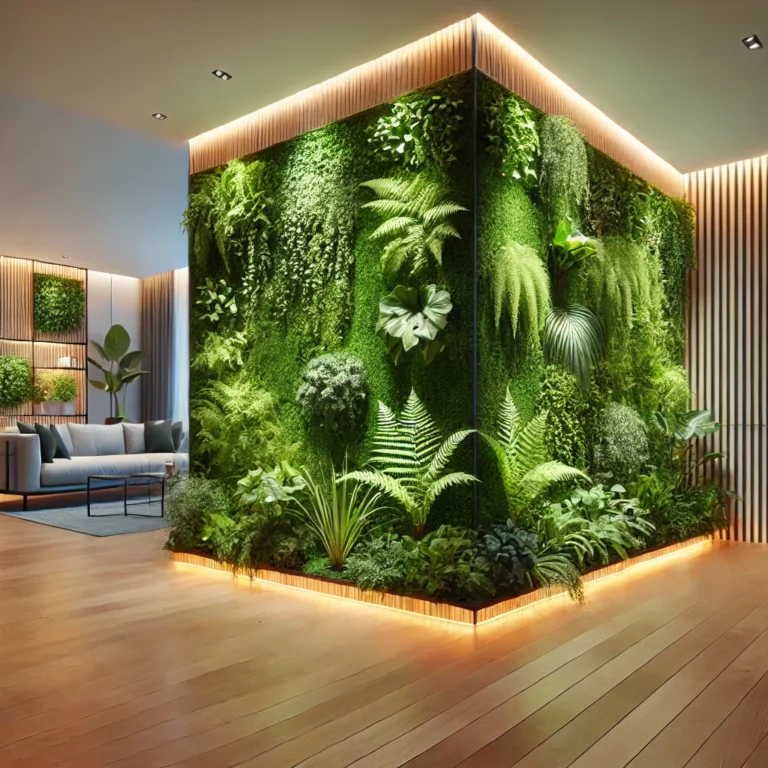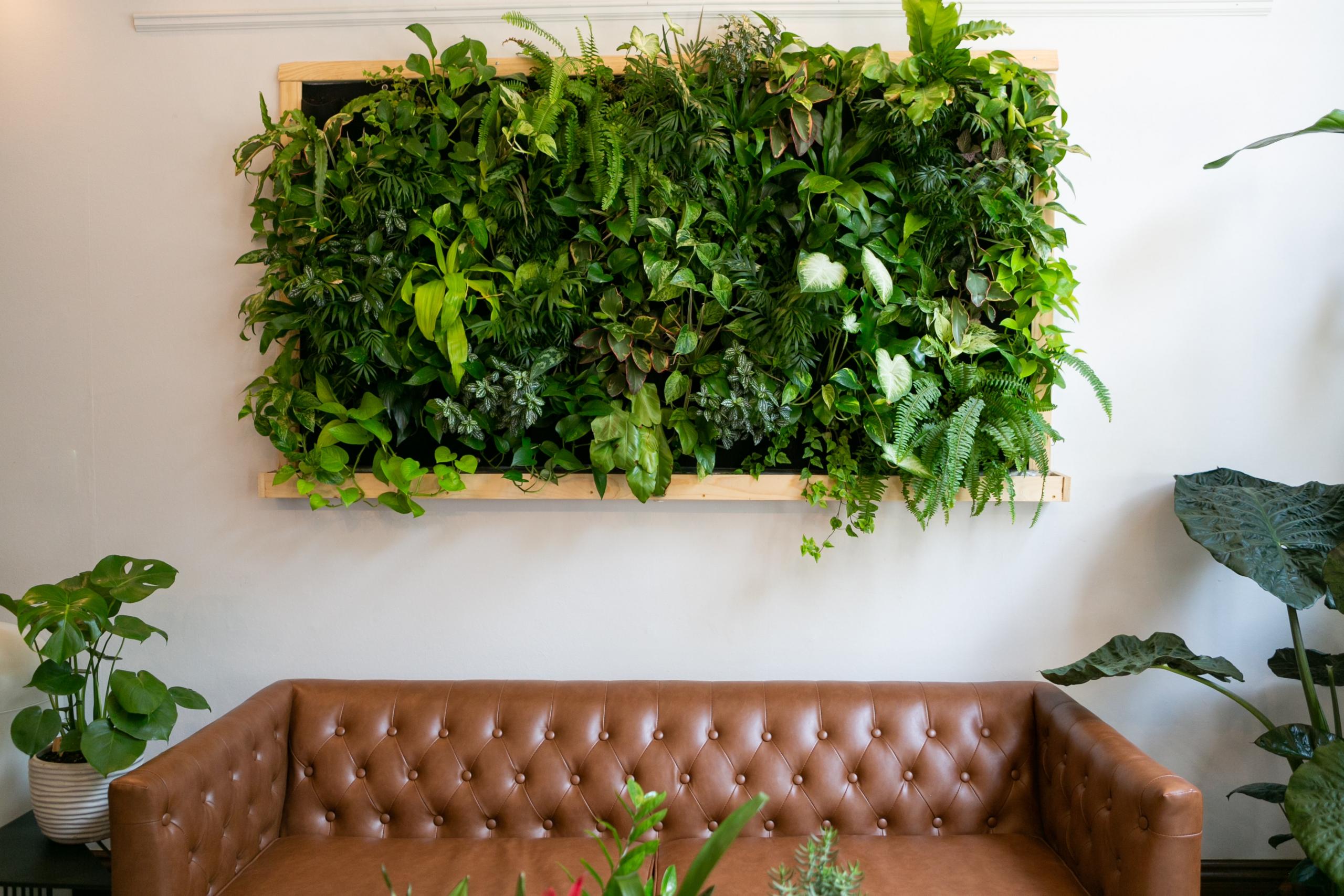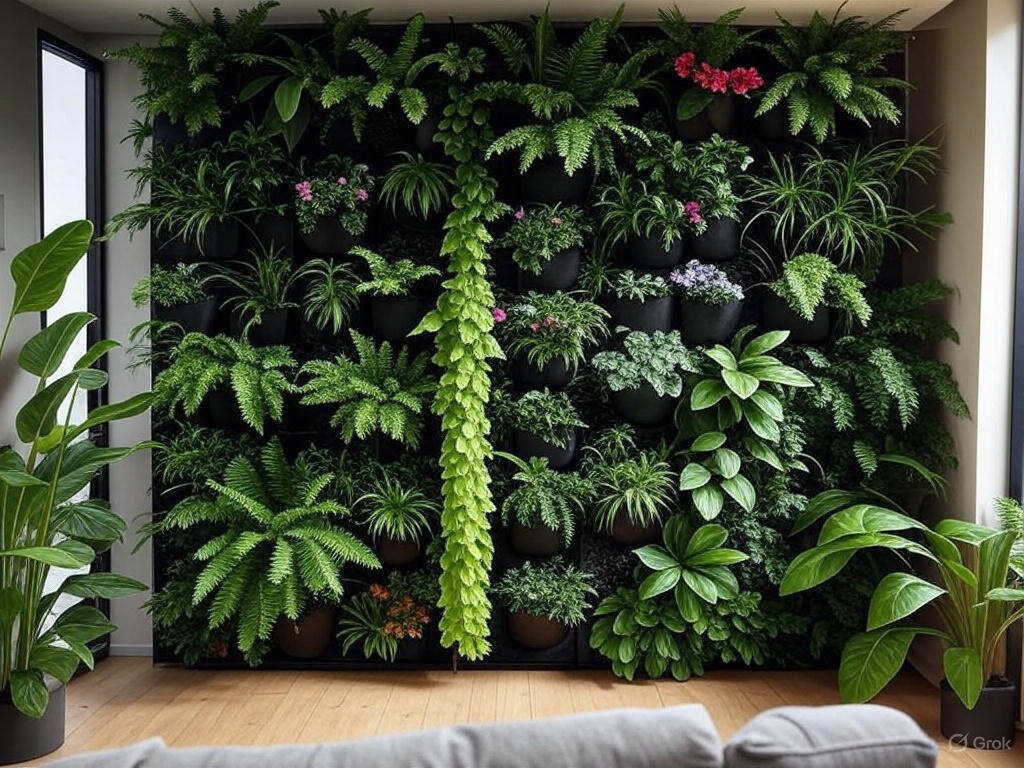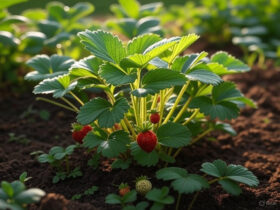Indoor vertical wall gardens are becoming increasingly popular. They offer a unique way to bring nature into your home.
Imagine turning a blank wall into a lush, green oasis. Indoor vertical wall gardens can transform any space. They add beauty, improve air quality, and boost your mood. You don’t need a lot of space or a green thumb. With the right setup, anyone can create a stunning vertical garden.
This blog post will explore the benefits and basics of indoor vertical wall gardens. Whether you’re a city dweller or just love plants, this guide will inspire you to start your own indoor vertical garden. Let’s dive in and discover how you can bring this green trend into your home.
Benefits Of Vertical Gardens
Indoor vertical wall gardens are becoming increasingly popular in urban homes. They bring a touch of nature indoors, creating a serene environment. But these gardens offer more than just aesthetic appeal. The benefits of vertical gardens are numerous, ranging from improved air quality to efficient use of space. Let’s explore these benefits in detail.
Air Quality Improvement
An indoor vertical wall garden can significantly enhance air quality in your home. Plants absorb carbon dioxide and release oxygen, making the air fresher. This process also removes toxins from the air, such as formaldehyde and benzene.
Having a vertical wall garden indoor means you can enjoy these benefits even in limited spaces. Here are some ways an indoor vertical hydroponic garden improves air quality:
- Increased Oxygen Levels: Plants naturally produce oxygen, which can help you breathe easier.
- Reduction of Pollutants: Certain plants are known for their ability to filter harmful chemicals from the air.
- Humidity Control: Plants release moisture into the air, maintaining healthy humidity levels.
Consider using an indoor vertical garden kit to simplify the setup. These kits often include plants that are specifically chosen for their air-purifying qualities. Below is a table listing some common air-purifying plants:
| Plant | Benefits |
|---|---|
| Spider Plant | Removes carbon monoxide and formaldehyde |
| Peace Lily | Filters benzene, trichloroethylene, and formaldehyde |
| Boston Fern | Increases humidity and removes pollutants |
A vertical indoor garden system can transform your living space into a cleaner, healthier environment.
Table of Contents

Space Efficiency
Space efficiency is another compelling advantage of indoor vertical wall gardens. For urban dwellers, maximizing space is crucial. Vertical gardens make the most of wall space, leaving floor areas free for other uses.
There are several ways a vertical wall garden indoor optimizes space:
- Vertical Growth: Plants grow upwards, utilizing vertical space that would otherwise be unused.
- Wall-Mounted Systems: These systems can be attached to walls, conserving floor space.
- Compact Design: Indoor vertical garden kits are designed to fit into small areas.
An indoor vertical hydroponic garden is particularly efficient. Hydroponic systems use water to grow plants, eliminating the need for soil. This method allows for closer planting, saving even more space.
Below is an example of how a vertical indoor garden system can fit into various areas:
| Location | Suitable System |
|---|---|
| Kitchen | Small herb garden on the wall |
| Living Room | Decorative plant wall |
| Bedroom | Air-purifying plant system |
By integrating a vertical wall garden indoor, you can enjoy the beauty of nature without sacrificing valuable space.
Choosing The Right Location
Indoor Vertical Wall Gardens are a beautiful and practical way to bring nature inside your home. These gardens can transform any wall into a green oasis, improving air quality and adding a touch of serenity to your living space. Choosing the right location for your indoor vertical wall garden is crucial for its success. Proper placement ensures your plants receive the necessary light, and you can easily care for them. Below are some essential factors to consider when selecting the perfect spot for your green wall.
Light Requirements
Light is vital for the health of your indoor vertical wall garden. Plants need light to photosynthesize, which is essential for growth. Different plants have varying light requirements, so it’s important to choose a spot that matches their needs.
Here are some key points to consider:
- Natural Light: Position your vertical wall garden indoor near a window that gets plenty of sunlight. South-facing windows are ideal as they provide the most consistent light throughout the day.
- Artificial Light: If your chosen spot doesn’t get enough natural light, consider using grow lights. LED grow lights are energy-efficient and can be adjusted to provide the right spectrum of light for your plants.
- Light Duration: Most plants need about 12-16 hours of light per day. Use a timer to ensure your indoor vertical hydroponic garden gets the right amount of light consistently.
To help you decide, here’s a quick reference table:
| Plant Type | Light Requirement |
|---|---|
| Ferns | Low to Medium |
| Succulents | High |
| Herbs | Medium to High |
Choosing the right light setup ensures your indoor vertical garden kit thrives, providing lush greenery and vibrant growth.
Accessibility
Accessibility is another crucial factor for the success of your vertical indoor garden system. You need to be able to reach your plants easily for watering, pruning, and other maintenance tasks.
Consider these points:
- Height: Install your indoor vertical wall garden at a height that allows you to reach all the plants comfortably. Avoid placing it too high or too low.
- Maintenance: Regular maintenance is essential. Ensure you have easy access to each plant for pruning, cleaning, and checking for pests.
- Watering: If you have an indoor vertical hydroponic garden, make sure the water reservoir is easily accessible. This will make refilling and cleaning simpler.
Here are some tips to improve accessibility:
- Use a step stool if your garden is slightly out of reach.
- Install the garden near a water source to make watering easier.
- Choose lightweight planters that can be removed and replaced easily.
By ensuring your indoor vertical garden kit is accessible, you make caring for your plants less of a chore and more of a joy. This leads to healthier plants and a more enjoyable gardening experience.
Selecting Plants
Creating an indoor vertical wall garden can be a beautiful and practical addition to any home. Selecting the right plants is crucial to ensure your garden thrives. The right choice of plants will not only enhance the aesthetic appeal but also ensure easy maintenance and longevity. Let’s dive into the best plants for indoors and some seasonal considerations to keep in mind.
Best Plants For Indoors
Choosing the best plants for your indoor vertical wall garden is essential for a lush and vibrant display. Here are some top choices that are perfect for vertical wall garden indoor setups:
- Pothos: Known for its hardiness and low maintenance, Pothos is an ideal choice. It can thrive in low light and irregular watering.
- Philodendron: This plant is great for adding a touch of green to your indoor vertical hydroponic garden. It grows well in indirect light and is easy to care for.
- Ferns: Ferns such as the Boston Fern or Maidenhair Fern are perfect for adding texture. They prefer humid environments, making them ideal for indoor vertical garden kits.
- Succulents: Succulents like Jade Plant and Echeveria are excellent for vertical indoor garden systems. They require minimal watering and can thrive in well-lit areas.
- Spider Plant: Spider Plants are known for their air-purifying qualities. They are easy to grow and maintain, making them perfect for indoor vertical gardens.
| Plant | Light Requirements | Watering Needs |
|---|---|---|
| Pothos | Low to Medium | Once a week |
| Philodendron | Indirect Light | Keep soil moist |
| Ferns | Indirect Light | High humidity |
| Succulents | Bright Light | Once every 2 weeks |
| Spider Plant | Indirect Light | Moderate |
Seasonal Considerations
When planning your indoor vertical wall garden, it’s essential to consider seasonal changes. Different seasons can affect the light and temperature inside your home, which in turn impacts plant growth.
During the winter months, indoor environments can become drier due to heating systems. Ensure you choose plants that can handle lower humidity levels or take steps to increase humidity. For instance, using a humidifier or placing a tray of water near your plants can help. Plants like ferns and spider plants may need extra attention during this time.
In the summer, indoor spaces can get warmer and more humid. Plants like succulents and cacti thrive in these conditions. Make sure your indoor vertical garden kit is placed in an area where it can receive adequate light without getting too hot.
It’s also important to consider the light changes throughout the year. In winter, the days are shorter, and there might be less natural light. Use grow lights to supplement if necessary. In the summer, ensure plants are not exposed to too much direct sunlight, which can cause leaf burn.
- Winter: Increase humidity, provide extra light.
- Summer: Ensure good airflow, avoid direct midday sun.
- Spring/Fall: Adjust watering needs as the seasons change.
By considering these factors, you can maintain a healthy and thriving indoor vertical wall garden all year round.

Design Ideas
Indoor Vertical Wall Gardens are gaining popularity for their ability to transform spaces into lush, green environments. These gardens not only enhance the aesthetic appeal of homes but also promote a healthier indoor atmosphere. Let’s explore some creative design ideas to inspire your own vertical wall garden indoor.
Modern Aesthetics
For a sleek and contemporary look, consider integrating modern aesthetics into your indoor vertical wall garden. This design style focuses on clean lines, minimalism, and a sophisticated palette. Here are some ways to achieve this:
- Monochromatic Color Schemes: Use shades of white, black, and grey for planters and frames. This creates a cohesive and elegant look.
- Geometric Patterns: Arrange plants in geometric shapes or patterns. Triangles, squares, and hexagons add visual interest.
- Metallic Elements: Incorporate metal planters or frames. Stainless steel or brushed brass can add a touch of luxury.
An example of a modern indoor vertical hydroponic garden might include:
| Element | Description |
|---|---|
| Planters | Rectangular white ceramic |
| Frames | Black metal with clean lines |
| Plants | Monstera, ZZ plant, Snake plant |
Using an indoor vertical garden kit designed for modern aesthetics can simplify the setup. Kits often include the necessary components and instructions, ensuring a seamless integration into your living space.
Natural Themes
Creating a natural-themed vertical wall garden indoor is about embracing organic elements and earthy tones. This design idea focuses on mimicking the beauty of nature inside your home. Here are some tips:
- Wooden Planters: Use reclaimed wood or bamboo planters to add a rustic touch.
- Mixed Greenery: Combine a variety of plants such as ferns, ivy, and pothos. This creates a lush, layered effect.
- Natural Light: Position your garden near windows to ensure plants receive ample sunlight. This fosters healthy growth.
A natural-themed vertical indoor garden system might include:
| Element | Description |
|---|---|
| Planters | Wooden boxes or bamboo baskets |
| Frames | Natural wood or rope |
| Plants | Ferns, Ivy, Pothos |
An indoor vertical garden kit with natural elements can make the installation process easier. These kits often include eco-friendly materials and instructions to help you create a beautiful, nature-inspired space.
Installation Tips
Creating an indoor vertical wall garden is a fantastic way to bring nature inside your home. These gardens are not only aesthetically pleasing but also space-saving. Proper installation is crucial to ensure your vertical wall garden thrives. Here are some installation tips to help you get started.
Wall Mounting Options
Choosing the right wall mounting options is essential for your indoor vertical wall garden. The mounting system should support the weight of the plants, soil, and water. Here are several options:
- Hooks and Brackets: Use sturdy hooks and brackets that can hold the weight of your vertical indoor garden system. Ensure they are securely attached to the wall studs.
- Rail Systems: Rail systems allow for easy adjustment and customization of your indoor vertical garden kit. You can slide the planters along the rails to optimize light and space.
- Modular Panels: Modular panels are a flexible choice. They come in various sizes and can be expanded as needed. They also provide a strong base for your vertical wall garden indoor.
When installing, always check the weight capacity of your chosen mounting system. Use a level to ensure your garden is perfectly vertical. This prevents uneven water distribution and plant stress.
| Mounting Option | Pros | Cons |
|---|---|---|
| Hooks and Brackets | Easy to install, inexpensive | Limited adjustability |
| Rail Systems | Highly adjustable, customizable | More expensive |
| Modular Panels | Expandable, strong support | Requires precise installation |
Watering Systems
Proper watering is crucial for the health of your indoor vertical wall garden. Different watering systems can be used, depending on your needs:
- Manual Watering: This is the simplest method. Use a watering can to directly water the plants. It’s suitable for small vertical wall garden indoor setups.
- Drip Irrigation: Drip irrigation provides consistent moisture to the roots. It uses a network of tubes and emitters. Ideal for larger or more complex indoor vertical hydroponic garden setups.
- Self-Watering Planters: Self-watering planters have built-in reservoirs. They automatically provide water to the plants. These are convenient for busy individuals.
When setting up your watering system, ensure it is compatible with your plant types. Overwatering and underwatering can harm your plants. Regularly check the moisture levels and adjust the system accordingly.
For those using drip irrigation, it’s important to install a timer. This ensures your plants receive water at regular intervals, even when you’re not home. Self-watering planters require periodic refilling of the reservoirs. Manual watering requires consistent attention.
| Watering System | Pros | Cons |
|---|---|---|
| Manual Watering | Simple, inexpensive | Time-consuming |
| Drip Irrigation | Efficient, consistent | Requires setup, maintenance |
| Self-Watering Planters | Convenient, automatic | Periodic refilling needed |

Maintenance Essentials
Indoor Vertical Wall Gardens bring a slice of nature into your home, improving air quality and adding aesthetic appeal. To keep your garden thriving, regular maintenance is crucial. Below, we delve into the essential aspects of maintaining your vertical wall garden indoor.
Pruning Techniques
Pruning is vital for your indoor vertical wall garden. It keeps plants healthy and promotes growth. Here are some effective pruning techniques:
- Regular Trimming: Trim dead or yellowing leaves weekly. This helps prevent disease.
- Pinching: Pinch off the tips of plants to encourage bushier growth. Use your fingers or small scissors.
- Thinning: Remove excess seedlings in your indoor vertical hydroponic garden. This ensures space for healthy growth.
Proper tools make pruning easier. Consider these tools:
| Tool | Purpose |
|---|---|
| Pruning Shears | Cut thick stems and branches |
| Scissors | Trim small leaves and flowers |
| Gloves | Protect hands from thorns and sap |
Pruning promotes airflow and light penetration in your vertical indoor garden system. This keeps your plants healthy and vibrant.
Pest Management
Pests can harm your indoor vertical garden kit. Effective pest management is crucial. Here are steps to control pests:
- Regular Inspection: Check plants weekly for pests. Look under leaves and stems.
- Natural Remedies: Use neem oil or insecticidal soap. These are safe for your plants.
- Quarantine: Isolate infected plants. This prevents pests from spreading.
Identifying common pests helps in their control. Here’s a quick guide:
| Pest | Signs | Solution |
|---|---|---|
| Aphids | Sticky residue on leaves | Spray with soapy water |
| Spider Mites | Webbing on plants | Use neem oil |
| Mealybugs | White cotton-like clusters | Wipe with alcohol |
Maintaining a clean environment helps in pest management. Remove debris and fallen leaves from your vertical garden. This reduces hiding spots for pests.
Cost Considerations
Indoor Vertical Wall Gardens are gaining popularity for their aesthetic appeal and space-saving benefits. Understanding the costs involved is crucial before starting your green project. This section delves into the cost considerations associated with setting up and maintaining an indoor vertical wall garden.
Initial Setup Costs
Setting up an indoor vertical wall garden involves various costs. Here’s a breakdown of the key expenses:
- Indoor Vertical Garden Kit: These kits can range from $50 to $300, depending on their size and features.
- Plants: The cost of plants varies widely. Expect to spend around $5 to $20 per plant.
- Planters and Containers: Planters can cost between $10 and $50 each, depending on material and design.
- Lighting: If your wall garden is away from natural light, you will need grow lights. These can cost between $30 and $150.
- Mounting Hardware: Wall mounts, hooks, and other hardware will add another $20 to $100.
Here’s a table summarizing these costs:
| Item | Estimated Cost |
|---|---|
| Indoor Vertical Garden Kit | $50 – $300 |
| Plants | $5 – $20 per plant |
| Planters and Containers | $10 – $50 each |
| Lighting | $30 – $150 |
| Mounting Hardware | $20 – $100 |
These costs can vary based on your choices and the size of your vertical indoor garden system. Planning your budget carefully helps avoid unexpected expenses.
Long-term Care Expenses
Maintaining an indoor vertical wall garden requires ongoing investment. Here’s a breakdown of long-term care expenses:
- Watering System: Automatic watering systems save time and water but cost about $50 to $200.
- Plant Replacement: Some plants may need replacing over time. Budget around $50 to $100 annually.
- Fertilizers and Nutrients: These are essential for plant health. Expect to spend around $20 to $50 yearly.
- Electricity: If using grow lights, your electricity bill may increase by $5 to $15 per month.
- Pest Control: Keeping pests at bay may require occasional treatments, costing around $20 to $50 annually.
Here’s a table summarizing these long-term care expenses:
| Item | Estimated Annual Cost |
|---|---|
| Watering System | $50 – $200 |
| Plant Replacement | $50 – $100 |
| Fertilizers and Nutrients | $20 – $50 |
| Electricity | $60 – $180 |
| Pest Control | $20 – $50 |
Maintaining a vertical wall garden indoor requires commitment. Understanding these costs will help you keep your indoor vertical hydroponic garden thriving and beautiful.

Frequently Asked Questions
What Is An Indoor Vertical Wall Garden?
An indoor vertical wall garden is a space-saving way to grow plants vertically.
How Do You Set Up A Vertical Wall Garden?
Choose a wall, install planters, and add plants. Ensure proper light and watering.
What Plants Are Best For Vertical Wall Gardens?
Herbs, succulents, and ferns work well. They thrive in vertical setups.
Do Vertical Wall Gardens Need Special Care?
Yes, they need regular watering, light, and occasional trimming to stay healthy.
Can Vertical Wall Gardens Improve Air Quality?
Yes, they can help purify the air by absorbing pollutants and releasing oxygen.
Are Vertical Wall Gardens Suitable For Small Spaces?
Absolutely. They are perfect for small apartments and homes with limited space.
How Much Light Do Indoor Wall Gardens Need?
They need natural or artificial light for at least 6 hours a day.
Conclusion
Indoor vertical wall gardens offer a delightful way to enhance home spaces. They bring nature indoors, adding beauty and freshness. These gardens are simple to set up and maintain. Perfect for small areas, they make homes feel more alive. They also improve air quality, promoting a healthier environment.
Choosing the right plants is key for a thriving garden. With some creativity, your wall garden can become a stunning focal point. Enjoy the benefits of this green addition. Invite tranquility and charm into your living space. Start your indoor vertical garden journey today.










Leave a Reply